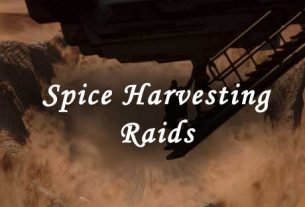In Dune: Awakening, death is never far away, especially when navigating the hostile environments of the Deep Desert. With a blend of environmental hazards and the constant threat of PvP combat, death mechanics are key to the gameplay. These mechanics differ depending on the cause of death, and they add a layer of tension and strategy to the experience.
Regular Death (PvP or PvE)
When players meet their end from combat, environmental dangers, or any hazard other than sandworms, they face a variety of consequences. These are:
- Resource Loss: Players will drop a percentage of their carried resources, including spice and Solari (the in-game currency). The specific percentage varies, but it’s a significant loss in any survival scenario.
- Gear Durability: When dying in designated PvP zones, players will experience durability damage to their equipped gear. While gear is not lost, its effectiveness is temporarily reduced until it is repaired.
- Right of Salvage: The Deep Desert is a lawless place where players can loot the dropped resources of fallen opponents. This rule creates opportunities for others to scavenge valuable items from defeated players.
While dying from PvP or environmental causes is certainly an inconvenience, the consequences are manageable. The game encourages players to stay vigilant, strategize effectively, and keep their resources and gear in top condition to mitigate these setbacks.
Death by Sandworm – A Catastrophic Loss
Among the many threats on Arrakis, sandworms are the deadliest. When a player is killed by a sandworm, the consequences are far more severe than any other form of death in the game:
- Complete Loss: Death by sandworm results in the loss of all carried items and equipment. Players respawn with nothing but their base knowledge and skills. This is the most punishing of the death mechanics and can set back a player’s progress significantly.
This extreme penalty highlights the immense danger posed by sandworms. Unlike regular death scenarios, which offer room for recovery, death by sandworm can wipe out weeks of progress in an instant. Therefore, players must exercise extreme caution when venturing into the open desert.
Strategies for Surviving the Sandworm Threat
To avoid the catastrophic loss associated with sandworm death, players must be prepared. Here are a few key strategies for dealing with sandworms:
- Avoidance Is Key: Prioritize staying away from known sandworm areas, especially while engaging in activities like spice harvesting or combat in wormsign zones. The desert is full of dangers, and sometimes the best choice is to simply avoid confrontation.
- Utilize Thumpers: Players can use thumpers to divert the attention of sandworms. These devices create vibrations that draw sandworms away, allowing players to safely engage in certain activities or travel through dangerous areas.
- Team Coordination: Players can work together to create distractions or guide sandworms away from key locations. Working with others increases the chance of survival and minimizes risk in high-risk areas.
One of the most interesting mechanics is the “anti-tease” rule, where exploiting sandworm AI pathing near rocky terrain results in an instant sandworm attack. This system forces players to play with respect for the environment, adding an extra layer of tension to every action.
The death mechanics in Dune: Awakening play a vital role in the game’s immersive and challenging experience. By offering different levels of punishment based on the cause of death, the game encourages players to make strategic decisions, stay vigilant, and embrace the dangers of the unforgiving desert. Whether it’s a minor setback from regular death or a devastating loss from a sandworm, these mechanics elevate the tension and excitement, making survival on Arrakis an exhilarating challenge.



